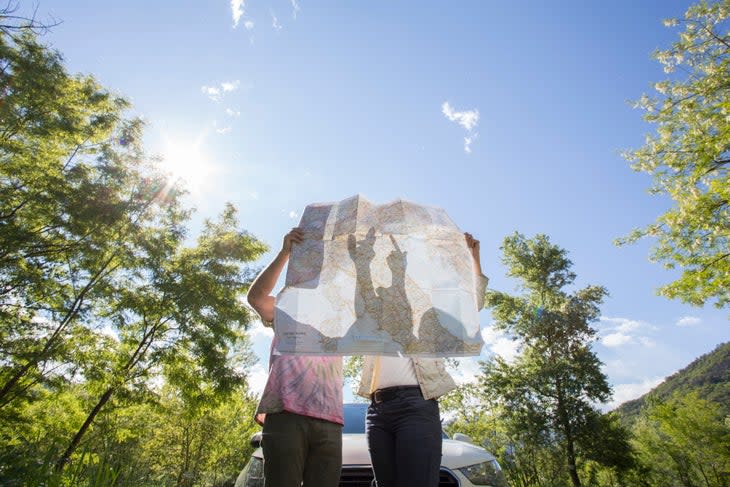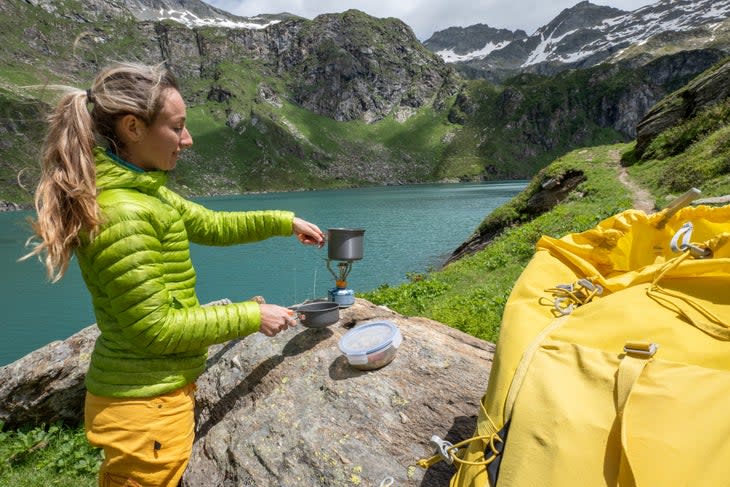A Beginner’s Guide to Fastpacking
This article originally appeared on Trail Runner
While fastpacking occupies a small niche, it is rapidly growing as more runners discover the liberating feeling of carrying everything you need on your back and sleeping wherever you end up ... usually in a gorgeous place.
Whether you spend one night or a week out, the goal for us fastpacking trail runners is usually to run a lot of the flats and downhills and power hike the climbs--the key is carrying the lightest load possible. While aspirants fear that to do so, they may need to adopt the old military adage, "travel light, freeze at night," modern ultralight gear makes it possible to avoid the freezing part.
Pack Smart
Ideally, strive to keep your fastpacking kit under 20 pounds, and food and water under five pounds. This presents obvious challenges for spending multiple nights in the backcountry and should turn you into an obsessive ounce counter. Due to the limited pack space, select food for its caloric density. Water is heavy, so plan to refill and treat en route (a key factor in route selection).
Says Will Thomas, who has summitted over 500 peaks (many of them while fastpacking) as well as Section J of the PCT in just 36 hours, "I try to use the smallest pack possible for the outing. This helps me be mindful in the packing process to bring only the essentials and focus on multi-use items and their compactibility. If I start with a larger pack than needed, I add more and more discretionary items."
Usually in the 25- to 35-liter range (depending upon trip length and location), the pack itself is the most crucial gear choice and should ride snug against the back and above the hips, with little bounce. Ideally (if you don't use a bladder), water bottles will be reachable and plenty of pockets around the chest and hips will allow you to access food, phone, map and compass and other essentials without having to stop and take off your pack.
Thomas does splurge on a couple of luxury items. "You'll never catch me out overnight without my two-ounce inflatable pillow and, if the nights are cold, I'll always bring my 12-ounce cooking setup."
Pro Tip / If your pack isn't waterproof, place everything inside the main compartment into a trash-compactor bag.
Prioritize items that serve more than one purpose. For example, that folding foam pad lining the inside of your pack can be used as your sleeping and sitting pad as well, with your pack itself providing an insulating barrier so you can avoid carrying a full-length sleeping pad. Trekking poles can pair with a weight-saving, pole-less ultralight tent or tarp.
Fastpacking with a partner or two (choose wisely! Emphasize fitness, experience and compatibility) allows you to spread the load--an ultralight tent can be split between friends, and you can get by with just one water filter, stove, satellite-communication device and other shareable items.
Prior to leaving for the backcountry, take your fully loaded fastpack for test runs on local trails, assessing unwanted bouncing and overall comfort and fit. As pack weight increases, it becomes more prone to bouncing, which leads to shoulder fatigue and potential issues with chafing at pressure points.
Pro Tip / Most of us don't train with 20-plus pounds on our backs--before embarking on a fastpacking mission, work up to running and power hiking with a load, including on a few weekend long runs, and wearing the shoes and apparel you intend to use fastpacking.

Dress for the Occasion
Most trail runners already own everything they need, which will, of course, depend upon the environment, climate and season of your destination. The biggest mistake budding fastpackers make is simply bringing too many clothes. For a typical summer mountain fastpack, you will need (at most, bring spares for under layers):
* Short-sleeve top
* Long-sleeve top
* Light insulating layer
* Running shorts and tights/underwear
* Lightweight waterproof-breathable rain gear
* Ball cap and beanie
* Light gloves
* Wicking socks (+ spare pair)
* Sturdy trail-running shoes
According to Gavin Woody, the winner of Minnesota's Arrowhead 135 Mile Race, joint winner of the 350-mile Iditarod Trail Invitational and winner of the Bigfoot 200, "Although it is tempting to go super light on mountain trips, it will be colder at higher elevations and you'll lose body heat quickly after a hard day on the trail. When choosing insulated clothing, aim for something that is extremely packable but also retains warmth when wet, for example, Patagonia's Micro Puff.
"Also, in lieu of a heavier, warmer sleeping bag, you may opt for a puffy jacket and puffy pants, which you can wear inside your bag."
RELATED: Our Favorite Fastpacking Gear

Eat Well
As previously mentioned, bring compact and nutrient-calorie dense foods. Keep food for the day accessible and stow other food in gallon Ziploc(s).
Pro Tip / You might consider one of UltraPedestrian Ras Vaughan's favorite combos: Oreo cookies dipped in coconut oil.
For breakfast, good options include instant coffee (e.g. Starbucks Via), instant oatmeal or potatoes, bars and jerky. Lunch is usually an all-day snacking affair, just like long trail runs, and may include gels, bars, trail mix/nuts, nut butters, cheese and dried fruit.
Says Woody, "A warm meal is a luxury on a fastpacking mission so, if you must have one, choose the lightest-possible setup (tiny stove, titanium cup and foil windscreen)."
While they're not something you will want to make a habit of eating, freeze-dried meals have come a long way in nutrition and taste, and make a gratefully easy-to-prepare meal at the end of a long day. Ramen and mac and cheese are quick and satisfying supplements as well. And, of course, you'll want to include some chocolate bars or some kind of treat for deserts.
Pro Tip / Never bring anything fastpacking that you haven't tried and tested before, from apparel to food to gear.
RELATED: What Gear Do You Need For Fastpacking?
Plan Ahead
Planning for fastpacking can be one of the more fun aspects of the endeavor as well as one of the more challenging. To set reasonable daily mileage expectations, your primary considerations will be fitness, terrain/technicality, elevation change, altitude and access to water.
Don't underestimate the toll of carrying 20-plus pounds in rugged country for multiple miles and days. Be conservative, and don't plan to fastpack farther than your recent longest training runs.
Pro Tip / "Determine your primary mode of travel on the route chosen before you plan anything," says Heather Anderson, who holds the overall self-supported Fastest Known Time (FKT) on the Pacific Crest Trail-hiking it in 60 days 17 hours 12 minutes in 2013. (Her book Thirst: 2600 Miles to Home chronicles her PCT record). "Whether you'll be mostly running or hiking affects every facet of planning from type of calories to pack selection. Be realistic about your abilities and the route."
Other factors will be the area's camping and travel rules and permits (plan ahead!), and, naturally, plan to practice Leave No Trace principles.
Safety should always be the paramount consideration. Remember, there are no aid stations so backcountry wilderness skills, experience and savvy are your best assets. If something feels risky, don't do it. Avoid swollen-creek/river crossings, ankle-breaking chasm leaps and ridgetops during thunderstorms. A broken ankle 12 miles in takes the fun out of it! And always share your itinerary (and stick to it) and emergency escape routes (which you should plan) with at least one person you trust.
Pro Tip / During the planning process, consider consulting NOAA's interactive online map, which allows you to click on an area and get a pop-up weather window. Also consult the most recent maps and trip reports for the specific area you're planning to visit.
A few days prior to leaving, it's advisable to call the wilderness-ranger office that administers the area. Ask about trail conditions, weather expectations and recent issues (such as problem bears) in the area.
RELATED: Ras Jason Vaughan Is The Ultrafastpacker
Seek Shelter
If you haven't spent time backpacking, the biggest challenge of fastpacking might be what happens after the sun goes down, i.e. camping out. It can also be the most rewarding: pitch your shelter where you end your day's run, kick back under the stars for a hot meal and sleep like the dead. The key camping decisions are the type of shelter and sleeping system to use. Fortunately, the fast-and-light backpacking market has resulted in tons of great options.
Pro Tip / One of the cruxes of a fastpacking trip can be getting all that stuff to fit in your meager 25-liter backpack. One space-saving tip is to stuff your shelter and possibly sleeping bag into the bottom of the pack sans stuff sack (consider using a trash-bag pack
liner, though).
For shelter, the two primary options are a floorless tarp or tarp tent and a tradtional floored tent, either single or double wall. A tarp offers many creative pitching possibilities, a closer connection to nature with airy views and the freedom to cook beneath it with your shoes still on. Unfortunately, it can also foster a closer connection to mosquitos or other pests, depending upon your location and timing. Pitched properly, you can weather some pretty serious downpours underneath one.
Pro Tip / The thru-hiking crowd has popularized the use of the down quilt over a sleeping bag, which cuts out the weight of a hood and zipper, is cheaper, takes up less volume in your pack and gives easy venting options on sticky nights.
Many fastpackers, however, prefer the enclosed comfort of a traditional tent, and many options are designed pair with trekking poles so that you can avoid the weight of tent poles. Avoid bivy sacks, unless you like the claustrophobic feeling of being entombed in nylon, although they are a decent option when paired with a tarp in damp conditions and allow you to use a lighter sleeping bag.
Ben Luedke is an avid fastpacker and psychotherapist living in Bellevue, Washington.
For exclusive access to all of our fitness, gear, adventure, and travel stories, plus discounts on trips, events, and gear, sign up for Outside+ today.

